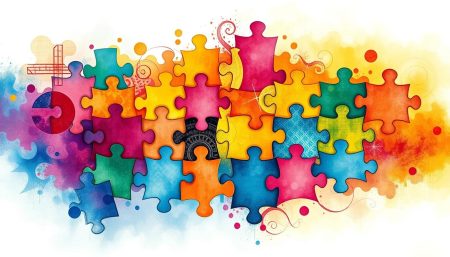Autism spectrum disorder (ASD) in adults can be very challenging. It often shows symptoms that were missed earlier. We aim to understand these symptoms better, helping to support and manage them.
These signs tell the stories of many adults facing life’s challenges. They show how autism affects their social, work, and personal lives. By grasping these details, we can better appreciate the spectrum’s diversity and clear up myths about autism in adults.
This guide helps people with ASD and those around them. It sheds light on how sensory issues, non-verbal communication, and social interactions work. It’s key to understanding autism’s complexities and creating a welcoming space for everyone.
Introduction to Autism Spectrum Disorder in Adults
Autism Spectrum Disorder (ASD) is a complex condition with varied autism spectrum symptoms in adults. These symptoms can look different for everyone. It’s important to focus on understanding ASD in adults to help them.
It’s key to recognize how adults with ASD experience symptoms. This introduction helps us understand the subtle signs of ASD in adults. These signs are different from the obvious ones seen in children.
- Complex social interactions
- Subtle communication patterns
- Unique behavioral manifestations
Spotting ASD in adults requires detailed assessment methods. Finding it early can greatly improve their life. It helps them fit in socially and professionally.
Knowing about ASD helps everyone. It builds empathy and support. It turns challenges into chances for growth and understanding.
| Feature | Child Presentation | Adult Presentation |
|---|---|---|
| Social Interaction | May struggle with basic interactions, clear difficulty | Subtle difficulties, may manage basic interactions |
| Behavioral Patterns | Easily discernible, repetitive behaviors | Less obvious, may not be immediately apparent |
| Communication | Delayed or non-verbal in early years | May have sophisticated vocabulary but struggles with nuance and inference |
This guide encourages a new way of seeing autism spectrum symptoms in adults. We need to be thorough and understanding. This helps adults with ASD live better lives.
Common Misconceptions About Autism in Adults
Many people have wrong ideas about autism in adults. These myths can lead to bad information and hurtful stereotypes. It’s important to clear up these false beliefs to help understand and support autistic adults better. This section will look at some common myths and what research says about them.
Myth vs. Reality: Challenging Assumptions
One big myth is that autism only affects kids and they outgrow it. But, autism is a lifelong condition that affects people all their lives. Adults with autism show different signs than kids, which makes people think it’s not the same.
- Myth: All individuals with autism have the same symptoms.
- Reality: Autism shows up in many different ways in different people. It’s like a spectrum, with a wide range of abilities and challenges.
- Myth: Adults with autism are all intellectually impaired.
- Reality: Many adults with autism are smart and can be very good at things they love.
Why Autism Often Goes Undetected in Adults
It’s hard to find and diagnose autism in adults. Symptoms can be subtle, and doctors might not always know what to look for. Adults might not want to get diagnosed because of shame or not understanding what autism is.
- Many adults hide their symptoms to fit in better.
- They might be misdiagnosed with other mental health issues instead of autism.
- What people think autism ‘looks like’ can make it hard to see the real signs in adults.
It’s key to fight these myths and share the real facts about autism in adults. By changing old beliefs and improving how we diagnose, we can help more people accept and support autistic adults.
Adults Autism Spectrum Disorder Symptoms
Finding autism spectrum symptoms in adults is tricky because they can show up in many ways. This part talks about the signs that might mean someone has autism spectrum disorder (ASD) as an adult. It aims to help people understand this condition better.
ASD symptoms in adults can be different for everyone. They often affect how people talk, interact with others, and behave. These challenges can make everyday life and social interactions harder.
- Difficulty in maintaining conversations
- Limited or inappropriate social interactions
- Rigid routines or repetitive behaviors (e.g., hand-flapping, rocking)
- Intense focus on specific topics
- Heightened or reduced sensory sensitivity
Also, adults with autism signs might look like they have other conditions. This can make it hard to get a correct diagnosis. Knowing these signs is important for getting the right help and support.
| Communication Challenges | Behavioral Signs | Social Interaction Difficulties |
|---|---|---|
| Delayed response times in conversations | Strict adherence to routines | Struggles with eye contact and body language |
| Literal interpretation of phrases | Repetitive movements or speech patterns | Limited interest in social activities |
| Challenges in expressing needs or emotions | Unusual responses to sensory input | Misinterpretation of social cues or norms |
Learning about autism spectrum symptoms in adults can help a lot. It can make it easier to manage and get the right help. Knowing and understanding these symptoms is key to supporting adults with ASD.
Communication Challenges Faced by Adults with Autism
Many adults with autism find everyday talks tough. They face challenges in both talking and body language. This affects their personal and work life a lot.
Verbal Communication Nuances
Getting the small talk right is hard for adults with autism. They might miss sarcasm, tone changes, and sayings. Choosing the right words can also be tricky, making social talks harder.
Non-Verbal Communication and Body Language
Reading body language is tough for them too. Facial expressions, posture, and eye contact are hard to get. This can make them seem awkward and anxious in social situations.
Here’s a table showing how adults with autism communicate differently:
| Standard Communicative Behavior | Behavior Exhibited by Adults with Autism |
|---|---|
| Regular use of gestures | Limited or exaggerated use of gestures |
| Maintaining eye contact | Avoids eye contact |
| Understanding sarcasm and jokes | Takes language literally |
| Appropriate tone of voice | Monotone or inappropriate modulation |
| Quick response in conversations | Delayed responses, needs more time to process |
This table shows how autism affects talking and body language. It’s key to understand these differences to help adults with ASD better.
Social Interaction and Autism
Many adults with autism find social interactions hard. They struggle with social cues, leading to anxiety and withdrawal. This shows how important it is to support them with strategies tailored to their needs.
Understanding Social Cues
Getting social cues right is key for good social interactions. But, adults with autism often find this tough. They might miss sarcasm, body language, or emotional signs, causing misunderstandings.
Being aware and getting help is vital to overcome these challenges.
The Impact of Social Anxiety and Withdrawal
Social anxiety is common for adults with autism in social situations. This can make them withdraw, missing out on social and professional chances. It’s important to spot and help with signs of withdrawal.
This helps manage autism’s effects on an adult’s life. It’s also key when making a autism symptoms in adults checklist or strategies for detecting autism in adults.

The table below shows how adults with autism might react in social situations. It contrasts with typical responses, showing the need for understanding and support:
| Social Scenario | Typical Adult Response | Adult with Autism Response |
|---|---|---|
| Group Conversation | Engages with occasional contributions | May remain silent or appear disinterested |
| Casual Greeting | Responds with reciprocal greeting | May ignore or not recognize the greeting |
| Non-Verbal Cues | Responds appropriately to body language | Struggles to interpret, may misread the situation |
Knowing these differences is key to creating supportive environments for adults with autism. It also helps improve resources and training, like social skills classes, to help them navigate these challenges.
Routines and Behavioral Patterns in Adults with Autism
People with autism spectrum disorder often have clear behavioral patterns and a love for routines. These routines make them feel safe and in control. But, when these routines are broken, it can cause a lot of stress and anxiety.
Repetitive behaviors in adults with ASD are more than just habits. They are ways to deal with the world’s chaos and social challenges. It’s important to understand these behaviors to support them well.
- Adhering to strict routines
- Repetition of physical movements
- Specific organization of personal items
Breaking these routines can upset their emotional balance. This shows the need for structured support. Learning about these behaviors helps us understand autism better and plan better support for each person. For more on autism, check out this resource.
| Behavior | Description | Impact on Daily Life |
|---|---|---|
| Compulsive Organization | Need to arrange items in a precise order | Provides predictability and control |
| Ritualistic Behaviors | Fixed routines for daily activities | Reduces stress and anxiety |
| Repetitive Movements | Repeated physical movements such as rocking or hand-flapping | Helps in coping with sensory challenges |
These behaviors might seem strange to those who don’t know about autism. But, it’s key to understand and respect the signs of autism in adults and the repetitive behaviors in adults with ASD. This helps them live better in different settings.
Emotional Regulation and Sensory Sensitivities
Adults with autism face unique challenges, like sensory processing and emotional regulation. They often feel too sensitive to things others ignore. This can be anything from the hum of lights to the feel of fabrics.
Emotional challenges in ASD make it hard to control feelings. These challenges grow when they’re hit with too much sensory stuff. It’s key to tackle these issues to improve life and fit in better with society.
- Identifying triggers: Recognizing specific sensory stimuli that lead to discomfort or stress.
- Adaptive strategies: Utilizing techniques such as controlled exposure to distressing stimuli to build tolerance gradually.
- Support systems: Leveraging therapeutic and familial support structures to navigate complex emotional landscapes.
This detailed plan helps adults with these sensitivities to not just survive but to flourish. Let’s dive deeper into the sensory hurdles they face and how to ease the emotional burden.
| Sensory Trigger | Common Reaction | Coping Mechanism |
|---|---|---|
| Loud Noises | Heightened anxiety or panic | Use of noise-cancelling headphones or earmuffs |
| Bright Lights | Headaches or eye strain | Adjustment of lighting in personal/work spaces |
| Crowded Spaces | Overwhelm or distress | Practice of mindfulness techniques |
| Unexpected Touch | Discomfort or agitation | Personal boundary settings and communicative strategies |
With the right tactics, adults with ASD can better handle sensory and emotional hurdles. This opens up new paths to personal and professional success.
Signs of Autism in Adults in Personal Relationships
Understanding characteristics of autism in adults is key when looking at personal relationship dynamics and ASD. Adults with autism face unique challenges in close relationships. These challenges affect both their intimate and casual friendships.
Challenges in Intimate Relationships
Intimate relationships for adults with ASD can be tough. They often face misunderstandings and emotional gaps. This is because they may struggle with social cues and need a lot of personal space and routine.
Friendships and Social Circles
Friendships need special efforts, showing the need for patience and understanding. Adults with autism might find it hard to start and keep friendships. This is because they prefer quieter places and struggle in big social settings.
| Relationship Type | Common Challenges | Strategies for Improvement |
|---|---|---|
| Intimate Relationships | Misreading emotional expressions, need for personal space | Open communication, setting clear expectations |
| Friendships | Initiating interactions, managing social anxiety | Structured social activities, role-playing social scenarios |
| Family Relations | Handling familial expectations, emotional regulation | Family therapy, consistent family meetings |
Professionally Navigating ASD Symptoms in Adults
It’s important to understand autism spectrum symptoms in adults to support them at work. Helping adults with autism find jobs is key. It makes the workplace better for everyone by adding different views.
Workplace Adaptations for Adults with Autism
Employers can make big changes to help adults with autism at work. They can change the work environment or offer flexible hours. For example, using noise-canceling headphones can help those who get distracted by sounds.
Clear communication is also important. This means using written instructions and regular feedback. Training staff to understand and support adults with autism is also helpful.
Securing Employment and Professional Development
Finding a job for adults with autism can be tricky. But, with the right support, it’s possible. Groups like the Specialisterne Foundation help companies adapt their hiring ways.
There are also programs to help adults with autism grow in their careers. These include mentorship and workshops. They help adults find jobs that fit their skills and make them happy.
By understanding and supporting adults with autism, employers can make their teams more diverse. This also makes the workplace more efficient by using everyone’s talents.
The Process of Diagnosing Autism in Adults
Diagnosing autism in adults is complex. Many people grow up without knowing they have autism. Doctors look at past and current behaviors to make a diagnosis. They adjust their methods for adults, unlike for children.
Late Diagnosis: Understanding the Path to Identification
Adults often realize they might have autism when they notice social and communication issues. They might start to wonder after researching or seeing differences with others. This journey can be tough and emotional for them.
Assessment and Diagnostic Criteria for Adults
Diagnosing autism in adults involves several steps. Doctors observe behavior and talk to the person and their family. They use special tools to understand the individual’s experiences fully.
| Assessment Tool | Description | Purpose |
|---|---|---|
| Autism Diagnostic Interview-Revised (ADI-R) | A structured interview conducted with the individual or a close relative. | Provides a thorough personal history focusing on early developmental stages and current function. |
| Autism Diagnostic Observation Schedule (ADOS) | Observational assessment where social and communication behaviors are observed. | Assesses social interaction, communication, and imaginative use of materials. |
| Self-Report Questionnaires | Questionnaires filled out by the individual possibly indicating symptoms aligned with autism spectrum behaviors. | Helps to gather data on a wider range of life experiences outside of direct observation. |
It’s important to understand and diagnose autism in adults. This ensures they get the right support and resources. With the right diagnosis, adults can get help tailored to their needs.

Adults with Autism Signs and Daily Living Skills
Understanding detecting autism in adults is key. We need to see how it impacts daily skills. This part talks about behaviors and daily challenges that show independence in adults with autism might be hard. It also shows how support can greatly improve their life.
Many adults with autism do well in daily tasks. But, they might find some self-care, organization, and money management hard. It’s important to know these signs to help them be more independent.
- Complexity in managing personal finances
- Difficulties with nuanced social interactions and relationships
- Challenges in consistent self-care and domestic tasks
Let’s look at some everyday activities and the support needed for adults with autism:
| Daily Skill | Common Challenges | Supports and Adaptations |
|---|---|---|
| Self-Care (Hygiene/Cooking) | Forgetting routines, sensory sensitivity to certain products | Visual aids, step-by-step guides, sensory-friendly products |
| Financial Management | Difficulty planning budget, managing expenses | Financial literacy programs, assisted budgeting tools |
| Social Interactions | Understanding social cues, anxiety in social settings | Social skills training, structured social activities |
The path to independence in adults with autism is not just about seeing their challenges. It’s also about a strong support system that meets their needs. Early detecting autism in adults helps in better strategies. This leads to a more independent life for adults with autism.
Coping Strategies and Support Mechanisms
Adults with autism face daily challenges. Finding effective coping strategies and support is key to a better life. The path to managing autism in adulthood often needs personalized solutions and a caring community.
Mental Health Resources and Therapy Options
Mental health support is vital for adults with autism. Cognitive behavioral therapy (CBT) helps with anxiety and social skills. Mindfulness and stress reduction also boost coping skills.
Community Support and Advocacy Groups
Community support and advocacy groups are also important. They offer a place for networking and support. They also help educate and advocate for better understanding and inclusion of people with autism.
| Support Type | Description | Benefits |
|---|---|---|
| Mental Health Therapy | Includes CBT, family therapy, and personal counseling. | Improves communication skills, reduces anxiety, and enhances emotional regulation. |
| Community Groups | Local and online groups focused on ASD support. | Provides a sense of belonging, practical support, and advocacy for rights. |
| Educational Workshops | Workshops on topics like job readiness, social communication, and rights awareness. | Equip individuals with practical skills and knowledge to improve independence and social integration. |
Combining therapy, community involvement, and education is a complete approach. It helps with personal growth and acceptance in society.
Detecting Autism in Adults: Knowing When to Seek Help
Recognizing the signs of autism in adults is a key step towards understanding oneself and getting support. Many adults face challenges that might be linked to Autism Spectrum Disorder (ASD). Identifying these signs and getting help for ASD can greatly improve one’s life and function in different settings.
Identifying signs of autism in adults can be tricky. It’s important to know what to look for and when to seek professional advice. Here are some common signs that might suggest an adult should consider an ASD evaluation.
- Difficulty in understanding social cues or maintaining conversations
- Struggles with traditional social constructs or relationships
- Repetitive behaviors or intense focus on specific interests
- Significant discomfort with changes in routine or unexpected events
- Heightened or reduced sensitivity to sensory inputs like light, sound, or textures
When several of these traits combine, they can significantly impact daily functioning and social interactions. This combination often prompts the need for guiding professional insights and possible diagnosis.
Reaching out for help can sometimes feel daunting. But, getting help for ASD involves compassionate professionals who understand autism. Support not only helps manage symptoms but also leverages unique strengths and abilities. Early intervention and support can lead to improved coping strategies and a better quality of life.
| Sign | Impact on Daily Life | Potential Benefits of Getting Help |
|---|---|---|
| Difficulty with social interactions | Challenges in personal and professional relationships | Improved communication skills and relationship management |
| Repetitive behaviors | Potential disruption in daily activities | Strategies to manage and redirect focus |
| Sensory sensitivities | Overwhelm in everyday environments | Techniques to reduce sensory overload |
Detecting and acknowledging the signs of autism in adults is an empowering step. If you or someone you know might be exhibiting these signs, consider exploring options for getting help for ASD.
Creating an Autism Symptoms in Adults Checklist
A autism symptoms in adults checklist is a key tool for monitoring ASD symptoms. It helps identify and understand autism traits in adults. This checklist is useful for both self-assessment and professional diagnostics.
Key Indicators to Monitor
- Difficulty in social interactions and understanding social cues
- Rigid behavior patterns and resistance to change
- Repetitive behaviors or speech patterns
- Challenges with verbal and non-verbal communication
- Unusual sensitivity to sensory input (e.g., light, sound, touch)
- Particular intense interests or fixations
When to Use a Checklist
Use an autism symptoms in adults checklist when you notice ongoing social, communication, or behavior challenges. It’s great for adults who think they might have ASD but haven’t been diagnosed. This tool helps prepare for a doctor’s visit, making it easier to share your experiences.
| Symptom | Details | Impact on Daily Life |
|---|---|---|
| Social Communication | Struggles with back-and-forth conversation, often misinterprets what others mean. | Makes social interactions challenging, potentially leading to social withdrawal. |
| Routine Dependency | High reliance on daily routines; extreme stress when changes occur. | Limits flexibility, affects professional and personal life adaptability. |
| Sensory Sensitivity | Overly sensitive to sensory inputs like sounds, lights, or textures. | Can lead to avoidance of certain places or situations, impacting social inclusion and job choices. |
| Special Interests | Intense focus on specific subjects or activities to the exclusion of others. | While often beneficial, it can interfere with other necessary daily activities or social interactions. |
Living with ASD: Personal Stories and Experiences
This section looks into the personal accounts of autism and the rich life experiences with ASD. It explores the everyday realities of individuals with autism. These stories show the challenges and unique abilities that define their lives.
The mosaic of personal experiences offers a deep look into autism. It helps break down stereotypes and promotes understanding of the autistic community.
| Aspect of Daily Life | Challenges | Triumphs |
|---|---|---|
| Social Interactions | Difficulty in reading social cues; social exhaustion | Developing meaningful relationships based on shared interests |
| Professional Environment | Navigating workplace politics; sensory overload | Utilizing unique skills in detail-oriented tasks |
| Personal Relationships | Misinterpretations in communication; emotional regulation | Deep connections with those who understand and accept their autism |
| Self-Care and Independence | Managing routine changes and sensory sensitivities | Learning and adapting strategies to maintain wellbeing |
These personal accounts of autism and diverse life experiences with ASD enrich our understanding. They help us appreciate the complexities and the colorful spectrum of autism. They empower those on the spectrum and those around them, building a supportive community.
Future Directions in Autism Research and Awareness
Looking ahead, we see a vast field of research on autism spectrum disorder (ASD). Scientists work hard to find new treatments and ways to understand ASD better. Their goal is to improve the lives of adults with autism.
Research is set to make a big impact. New technologies and medicines could lead to personalized treatments. This could change how we see and treat autism, showing its diversity and strength.
We must keep working together to support people with autism. This means better access to services, education, and jobs. By doing this, we can create a world that values and celebrates autism.
FAQ
Q: What are some common symptoms of autism in adults?
A: Symptoms vary but often include trouble with social interaction and communication. Adults might also prefer routine, repeat behaviors, and be sensitive to certain senses.
Q: How does Autism Spectrum Disorder (ASD) present differently in adults compared to children?
A: In adults, ASD symptoms can be harder to spot. They might have learned to hide their symptoms, making it tough to diagnose.
Q: What misconceptions exist about autism in adults?
A: Many think all people with autism are the same. Others believe adults can’t be diagnosed if they weren’t as kids.
Q: Why is autism often undetected in adults?
A: It’s often missed because symptoms are subtle. Adults might hide their signs by adapting. Lack of awareness and biases also play a part.
Q: Can adults with autism face communication challenges, and if so, what kind?
A: Yes, they might struggle with verbal and non-verbal communication. This includes understanding tone and body language.
Q: What are the impacts of social anxiety and withdrawal in adults with autism?
A: Social anxiety and withdrawal can hurt relationships and daily life. It might lead to feeling isolated and facing mental health issues.
Q: How do routines and behavioral patterns affect adults with autism?
A: Routines bring comfort and security. Disruptions can cause stress or agitation.
Q: What sensory sensitivities might adults with autism experience?
A: They might react badly to certain textures, sounds, tastes, smells, and sights. This can cause discomfort in everyday places.
Q: How can autism affect personal relationships in adulthood?
A: It can make social cues, emotional expression, and understanding in relationships hard. This can strain relationships.
Q: What workplace adaptations can help adults with autism?
A: Adaptations include clear communication, a structured work environment, and sensory-friendly spaces. Tailored support for social interactions and executive functioning is also helpful.
Q: How is autism diagnosed in adults?
A: Diagnosis involves a detailed evaluation by a mental health expert. It looks at developmental history, current symptoms, and how they affect daily life.
Q: What are the signs of autism in adults concerning daily living skills?
A: Signs include trouble organizing tasks, managing finances, and cooking. They might need clear instructions for tasks others find easy.
Q: What coping strategies and support mechanisms are available for adults with autism?
A: Strategies include therapy, joining support groups, making sensory accommodations, and social skills training.
Q: When should an adult consider seeking help for autism?
A: Seek help if you struggle with social interactions, communication, flexibility, and if it affects your life quality.
Q: How can an autism symptoms checklist be useful for adults?
A: It helps adults reflect on challenges and serves as a reference during assessments with healthcare professionals.
Q: Why is it important to share personal stories and experiences about living with ASD?
A: Sharing stories promotes understanding, empathy, and awareness. It helps combat stereotypes and stigma.
Q: What future directions are anticipated in autism research and public awareness?
A: Future directions include better diagnostic tools, personalized support, and increased education about adult autism. Advocacy for autistic individuals’ rights and inclusion is also expected.


















